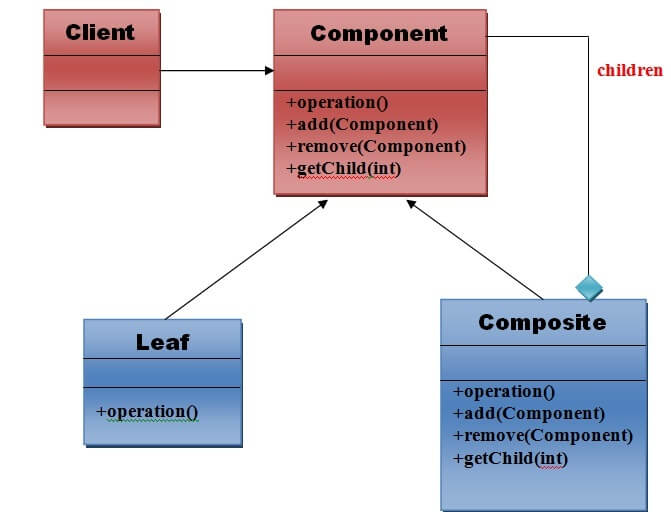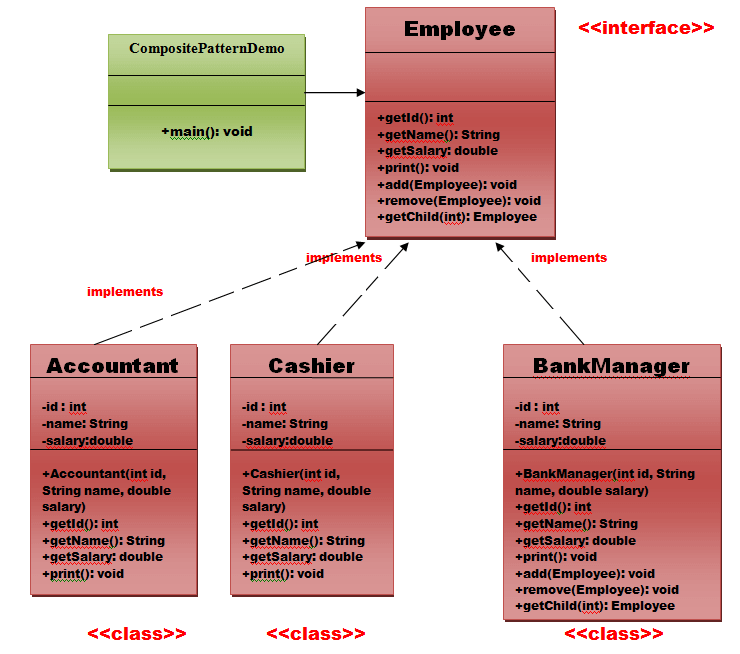复合模式说, 只是“允许客户端以通用方式对可能表示对象层次结构的对象进行操作”。
复合设计模式的优势
- 它定义了包含原始对象和复杂对象的类层次结构。
- 它使你更容易添加新的组件。
- 它通过可管理的类或接口提供结构的灵活性。
复合图案的用法
它用于:
- 当你要表示对象的全部或部分层次结构时。
- 需要将职责动态添加到单个对象时, 而不影响其他对象。对象的责任可能会不时变化。
用于复合模式的UML

复合模式中使用的元素:
让我们看看复合模式的4个元素。
1)组成部分
- 声明组成对象的接口。
- 根据需要为所有类通用的接口实现默认行为。
- 声明用于访问和管理其子组件的接口。
2)叶
- 表示组成中的叶对象。叶子没有孩子。
- 定义合成中原始对象的行为。
3)复合
- 定义具有子级的组件的行为。
- 存储子组件。
- 在组件界面中实现与子级相关的操作。
4)客户
- 通过组件接口操作合成中的对象。
注意:以上通用UML的工作流程如下。
客户端使用组件类接口与组合结构中的对象进行交互。如果收件人是叶子, 则将直接处理请求。如果接收者是复合用户, 则通常会将请求转发给其子代以执行其他操作。
复合图案示例
我们可以通过下面给出的UML图轻松理解复合设计模式的示例:

以上UML的实现:
步骤1
创建一个将被视为组件的Employee接口。
// this is the Employee interface i.e. Component.
public interface Employee {
public int getId();
public String getName();
public double getSalary();
public void print();
public void add(Employee employee);
public void remove(Employee employee);
public Employee getChild(int i);
}// End of the Employee interface.第2步
创建一个将被视为Composite的BankManager类, 并实现Employee接口。
// this is the BankManager class i.e. Composite.
import java.util.ArrayList;
import java.util.Iterator;
import java.util.List;
public class BankManager implements Employee {
private int id;
private String name;
private double salary;
public BankManager(int id, String name, double salary) {
this.id=id;
this.name = name;
this.salary = salary;
}
List<Employee> employees = new ArrayList<Employee>();
@Override
public void add(Employee employee) {
employees.add(employee);
}
@Override
public Employee getChild(int i) {
return employees.get(i);
}
@Override
public void remove(Employee employee) {
employees.remove(employee);
}
@Override
public int getId() {
return id;
}
@Override
public String getName() {
return name;
}
@Override
public double getSalary() {
return salary;
}
@Override
public void print() {
System.out.println("==========================");
System.out.println("Id ="+getId());
System.out.println("Name ="+getName());
System.out.println("Salary ="+getSalary());
System.out.println("==========================");
Iterator<Employee> it = employees.iterator();
while(it.hasNext()) {
Employee employee = it.next();
employee.print();
}
}
}// End of the BankManager class.第三步
创建一个Cashier类, 该类将被视为叶子并将其实现到Employee接口。
public class Cashier implements Employee{
/*
In this class, there are many methods which are not applicable to cashier because
it is a leaf node.
*/
private int id;
private String name;
private double salary;
public Cashier(int id, String name, double salary) {
this.id=id;
this.name = name;
this.salary = salary;
}
@Override
public void add(Employee employee) {
//this is leaf node so this method is not applicable to this class.
}
@Override
public Employee getChild(int i) {
//this is leaf node so this method is not applicable to this class.
return null;
}
@Override
public int getId() {
// TODO Auto-generated method stub
return id;
}
@Override
public String getName() {
return name;
}
@Override
public double getSalary() {
return salary;
}
@Override
public void print() {
System.out.println("==========================");
System.out.println("Id ="+getId());
System.out.println("Name ="+getName());
System.out.println("Salary ="+getSalary());
System.out.println("==========================");
}
@Override
public void remove(Employee employee) {
//this is leaf node so this method is not applicable to this class.
}
}步骤4
创建一个Accountant类, 该类也将被视为叶子, 并将实现到Employee接口。
public class Accountant implements Employee{
/*
In this class, there are many methods which are not applicable to cashier because
it is a leaf node.
*/
private int id;
private String name;
private double salary;
public Accountant(int id, String name, double salary) {
this.id=id;
this.name = name;
this.salary = salary;
}
@Override
public void add(Employee employee) {
//this is leaf node so this method is not applicable to this class.
}
@Override
public Employee getChild(int i) {
//this is leaf node so this method is not applicable to this class.
return null;
}
@Override
public int getId() {
// TODO Auto-generated method stub
return id;
}
@Override
public String getName() {
return name;
}
@Override
public double getSalary() {
return salary;
}
@Override
public void print() {
System.out.println("=========================");
System.out.println("Id ="+getId());
System.out.println("Name ="+getName());
System.out.println("Salary ="+getSalary());
System.out.println("=========================");
}
@Override
public void remove(Employee employee) {
//this is leaf node so this method is not applicable to this class.
}
}第5步
创建一个CompositePatternDemo类, 该类也将被视为Client, 并且ii将使用Employee接口。
public class CompositePatternDemo {
public static void main(String args[]){
Employee emp1=new Cashier(101, "Sohan Kumar", 20000.0);
Employee emp2=new Cashier(102, "Mohan Kumar", 25000.0);
Employee emp3=new Accountant(103, "Seema Mahiwal", 30000.0);
Employee manager1=new BankManager(100, "Ashwani Rajput", 100000.0);
manager1.add(emp1);
manager1.add(emp2);
manager1.add(emp3);
manager1.print();
}
}输出量
==========================
Id =100
Name =Ashwani Rajput
Salary =100000.0
==========================
==========================
Id =101
Name =Sohan Kumar
Salary =20000.0
==========================
==========================
Id =102
Name =Mohan Kumar
Salary =25000.0
==========================
=========================
Id =103
Name =Seema Mahiwal
Salary =30000.0
========================= srcmini
srcmini
评论前必须登录!
注册